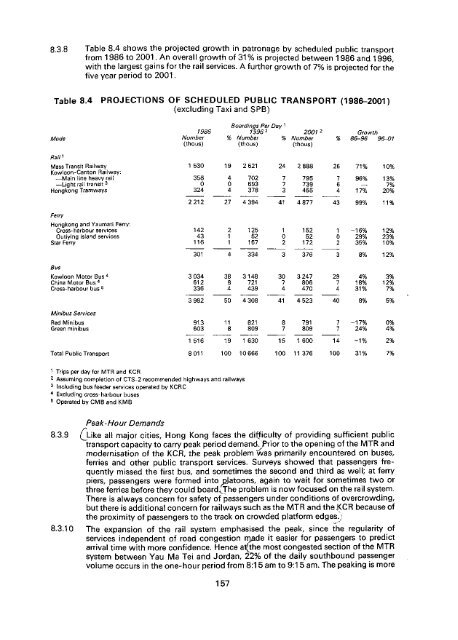Untitled - HKU Libraries - The University of Hong Kong
Untitled - HKU Libraries - The University of Hong Kong
Untitled - HKU Libraries - The University of Hong Kong
- No tags were found...
Create successful ePaper yourself
Turn your PDF publications into a flip-book with our unique Google optimized e-Paper software.
8.3.8 Table 8.4 shows the projected growth in patronage by scheduled public transportfrom 1986 to 2001. An overall growth <strong>of</strong> 31 % is projected between 1986 and 1996,with the largest gains for the rail services. A further growth <strong>of</strong> 7% is projected for thefive year period to 2001.8.4OF(excluding Taxi and SPB)Mode1986Number(thous)Boardings Per Day 11996 2y 0 Number %(thous)2001 2Number(thous)Growth86-96 96-01Mass Transit RailwayKowloon-Canton Railway:—Main line heavy rail—Light rail transit 3<strong>Hong</strong>kong Tramways1 530358 0324221219 26214 7020 6934 37827 4 39424 2 8887 7957 7393 455414877267644371%96%17%99%10%13% 7%11%Ferry<strong>Hong</strong>kong and Yaumati Ferry:Cross-harbour servicesOutlying island servicesStar Ferry14243116301125 5215733415252172376-16%29%35%8%12%23%10%12%BusKowloon Motor Bus 4China Motor Bus 4Cross-harbour bus 53034612336398238 84503148721439430830 74413247806470452329744018%31%3%12% 7%5%Minibus ServicesRed MinibusGreen minibus9136031 51611 8198218091 63079180915 1 60014-17% 24%-1%0%4%2%Total Public Transport801110010666100 11 37610031%7%1 Trips per day for MTR and KCR2 Assuming completion <strong>of</strong> CTS-2 recommended highways and railways3 Including bus feeder services operated by KCRC4 Excluding cross-harbour buses5 Operated by CMB and KMBPeak-Hour Demands8.3.9 (J-ike all major cities, <strong>Hong</strong> <strong>Kong</strong> faces the difficulty <strong>of</strong> providing sufficient publictransport capacity to carry peak period demand. )Prior to the opening <strong>of</strong> the MTR andmodernisation <strong>of</strong> the KCR, the peak problem was primarily encountered on buses,ferries and other public transport services. Surveys showed that passengers frequentlymissed the first bus, and sometimes the second and third as well; at ferrypiers, passengers were formed into platoons, again to wait for sometimes two orthree ferries before they could board(Jhe problem is now focused on the rail system.<strong>The</strong>re is always concern for safety <strong>of</strong> passengers under conditions <strong>of</strong> overcrowding,but there is additional concern for railways such as the MTR and the KCR because <strong>of</strong>the proximity <strong>of</strong> passengers to the track on crowded platform edges.,8.3.10 <strong>The</strong> expansion <strong>of</strong> the rail system emphasised the peak, since the regularity <strong>of</strong>services independent <strong>of</strong> road congestion rrjade it easier for passengers to predictarrival time with more confidence. Hence atjthe most congested section <strong>of</strong> the MTRsystem between Yau Ma Tei and Jordan, 22% <strong>of</strong> the daily southbound passengervolume occurs in the one-hour period from 8:15 am to 9:1 5 am. <strong>The</strong> peaking is more157
















